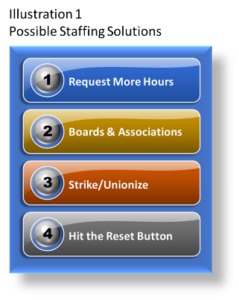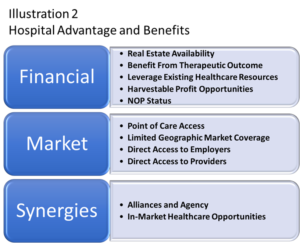Overworked, Understaffed Pharmacy
Investigative journalists once again have raised the specter of looming fatal pharmacy errors. The NBC News Investigative Unit cherry-picked this perennial favorite and published its findings on-line in an article on March 16, 2021[2]. While the words and source of quotes change, the message is the same. So too will be the outcome.
To be sure one can always find a disgruntled employee who feels overworked, underappreciated, and underpaid. The article states there are 155,000 chain drug store pharmacists and that size of workforce will have plenty of different opinions on what constitutes adequate time per prescription or patient.
Industry observers, however, are more likely to side with rank-and-file pharmacist. While the woes facing the industry go back almost two decades, it likely reached a tipping point for some. Internet sources reveal layoffs and salary downsizing reached the administrative level just over a decade ago almost certainly indicating store level layoff opportunities were drying up. While a layoff strategy is no strategy at all, it continues as one today.
So, in light of desperate measures taken by some drug chains to underpin profit growth for management and shareholders, what hope do rank-and-file pharmacists have that issues raised by investigative reports can ever be resolved?
Finding a solution …
Before looking for solutions, let’s look at what we know. First, staffing models are NOT the problem. How they are used or not used is. Metrics are NOT the problem. Once again, the weaponizing of metrics is the problem. I know this to be true because I have built and continue to build and customize patient-centric staffing models and metrics which could help pharmacist manage demand.
Second, industry observers and patients alike might agree that retailers have harvested time (staff) over the last two decades, stripping pharmacies of nearly all patient benefits for which pharmacist engagement would be necessary. Likewise, patient benefits which might accrue from non-pharmacist tasks have also been harvested.
Third, retailers are in the business of making and growing profit. Despite words to the contrary, there is little or no evidence to suggest technology investment maintained or grew patient-centric benefits. One only need observe that patient engagement did not return with the introduction of robotics.
Fourth, the pharmacy delivery model is hopelessly antiquated not having changed significantly for over a hundred years. To be sure, machines have replaced technicians in the pharmacy, but little else has changed.
Fifth, machine vendors continue to trade on task substitution rather than process innovation. Innovation, for the most part, has not yet touched the pharmacy landscape in any meaningful way for retailers or patients. Vendors would rather sell two or more machines rather than one which could perform the work of several. I saw a photo on LinkedIn in April, 2021 that illustrated this point perfectly. In it, a long line of single-fill machines replaced what would have been a line of technicians.
Sixth, the retail bias of pharmacy boards is part of the problem. This is not to say they could not play a significant role in creating a solution. But for now they serve management, owners, and shareholders.
How might pharmacists get back to being pharmacists rather than prescription gatekeepers and salesmen given these six realities? Illustration 1 provides a bleak list of available options.

Request More Hours … It makes for inciteful press, but the on-going investigative reports are not likely to accomplish very much. First, the lack of process and staffing transparency allow management to dissuade action by arguing proprietary methods, technological investments, and any number of other thin veiled defense/support for why pharmacy staffing is appropriate.
Second, investigative reports which have found government sponsorship for change depend on these same retailers for resolution. A legislative call for change based on a Chicago Tribute Investigative Report[1] of chain drug stores was defanged and declawed by the Illinois Collaborative Pharmaceutical Task Force. What started out as a call for pharmacists to have time for complying with existing regulations ended with pharmacies given the option to ‘close’ during the meal period … and even this had exceptions.
Third, retailers have already harvested hours for profit. Adding hours back to the pharmacy would require a transformation of the fulfillment process or dipping into profits to return the time to the pharmacy.
Boards & Associations … In my article on ‘Knowing Your Pharmacy Board’, I quantified and qualified membership bias in these organizations which ostensibly exist to ensure the professionalism of pharmacy practice and safety of the patients. As reported above, these organizations serve to protect the interest of chains and independent retailers.
Boards dominated by drug chains may favor regulations that help chains; independent biased boards favor regulations which make it difficult for chains to operate in the state. Both retailers make it nearly impossible for hospitals to operate the kind of outpatient pharmacy required to serve its patients. This despite the fact that only hospitals have a vested interest in preventing adverse drug affects and favorable therapeutic outcomes.
Strikes/Unionize … these never work in the long term. On the upside, it would spur transformation of the industry. The downside is that the transformation would lend itself to the elimination of pharmacists and unions.
Hit the Industry Reset Button … This option is appealing for a lot of reasons. It returns pharmacy to custodial responsibility of healthcare rather than retail. Some will argue both are evil in their own way. Still, it is wiser to choose the less evil of two options if this were the case.
There will always be a place for retail pharmacy (unless of course the government steps in). However, rather than being an unregulated healthcare provider, they would become subordinate to the same restrictions and accountability that healthcare providers have. Hospitals would serve the therapeutic needs of their markets directly or through hospital and retail alliances.
Hospitals are in the best position to reset the prescription delivery system. Illustration 2 shows some of the advantages hospitals have going into a prescription delivery system transformation. In addition to these, hospitals have an opportunity to transform the archaic delivery process into a more patient-centric, high capacity, and rapid delivery system.

Ascension and HCA health systems have already tested the retail pharmacy waters. Both health systems use retail drug store clones. This suggests that they are at a disadvantage to conventional retailers and are likely underperforming with respect to market potential.
It is important to recognize that hospital-centric prescription delivery models require a different conversion cycle than found in the existing retail model. The new process must out-cycle steps in the process in order to become more patient friendly and compatible with the shortened delivery window.
No doubt this transformation will require help from the government. Regulatory obstructions for the use of technology and operations suitable for hospital markets would need to be eliminated. A quick way to do this, and is long overdue, is to separate hospital and retail regulations. They should have never been co-mingled.
Another compelling reason for hospital-centric pharmacies is the add-back of competition. Competition from hospitals would most certainly push retailers to transform operations rather than simply invest in machines to reduce labor cost, however small that might be. The FTC has a lot to answer for given its tacit consent for elimination of competition from the industry. The decrease in competition is one of the reasons why retailers do not feel the need to invest in the patient.
Pharmacists, take thy own medicine …
Pharmacists are not faultless in the events driving the current state of the industry. The fact is that pharmacists not only colluded in its demise but may have even authored its blueprint.
Executives of some chains are or were themselves pharmacists. Pharmacists in other top management positions make decisions in drug chains even today. Staffing comes with the explicit or tacit approval of pharmacists. Even so, it is not uncommon to find these pharmacists echoing the need to change a system they continue to support.
In the meantime …
HCA and Ascension have enough inventory to begin making a difference in the markets they serve. Of course, this will require they take a hard look at the kinds of transformations necessary to take advantage of this inventory. Pharmacist working for these organizations can pursue things that make the pharmacy more patient-centric without adversely affecting the company business model. Feel free to check out my website for ideas and checkback now and then for additional ideas.
Taking control of pharmacy boards will also help. Review the state regulations and proactively advocate changes to focus on patient-centric pharmacy operations. Eliminate anti-competitive regulations. Eliminate restrictions on the use of technology. Work to restore reasonable tech ratios. Know your pharmacy board and attend meetings en-masse to ensure your profession is protected from retail management bias.
The best labor model is one that you have a hand in developing. Do not wait for someone else to impose one, or worse yet, set staffing without one. My interest in flexible staffing models was peaked when a courageous pharmacist came to me with her ideas for scheduling the pharmacy. She presented facts and sample task timings to support her schedule templates. Together, we built the first labor model that recognized staffing differences by market, volume, fulfillment and non-fulfillment tasks. It treated each pharmacy according to its needs. But, it all begins with understand your pharmacy facts and task timings.
Educate your legislatures. They only know what they are told. Do not let the only voice they hear be one protecting corporate profit and shareholders. Do not assume that the pharmacist lobbying Congress is working for you or the patient. Go to your representatives with facts and solutions. Playing the victim might get an investigative report, but it will not lead to change.
Be aware. Know what decisions are being made and when. The Illinois Collaborative Pharmaceutical Task Force was a lost opportunity for pharmacists to make their voices heard. The Chicago Tribune Investigation was very well done and raised very serious questions that could have made a difference. However, the public meeting minutes suggest that the emphasis may have been more about preventing transparency and interference than discussing and solving the problem they were charged with. Read the minutes and decide for yourself.
Hospitals … Know your consultant. Unfortunately, even the largest of the healthcare consulting companies lack proprietary experience in transforming pharmacies. Be wary of the firm that compares your performance to retail, especially those who offer a single metric for comparison. Consultants who lead with the potential to reduce labor should be avoided. Transformation comes first.
Footnotes
[1] Chicago Tribune Investigative Report: Pharmacies miss half of dangerous drug combinations … December 14, 2016; Same Roe, Ray Long and Karisa King
[2] NBC Investigative Report: Overworked, understaffed: Pharmacists say industry in crisis puts patient safety at risk. March 16, 2021; Adiel Kaplan, Vicky Nguyen and Mary Godie
About the Author
Sabrina Hannigan is a transsexual who was retired as major drug chain executive with over three decades experience in site analysis and operations optimization. Upon retiring, she contracted with a healthcare consulting firm to consult on a broad range of operational topics specific to build-out of an outpatient pharmacy service.
As an independent consultant, Sabrina recognized that retail solutions were not transferable and created an outpatient pharmacy business model incorporating methods and processes experienced over forty years in manufacturing and retail.
Sabrina is passionate about the future of healthcare and envisions hospital-centric solutions for improving therapeutic outcome and population health. Towards this end, she continues to develop new processes and methods for outpatient pharmacies.